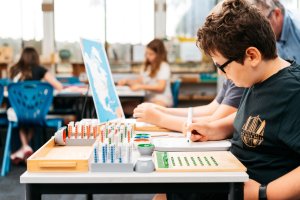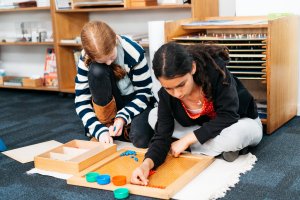As we continue to think about Montessori education and the development of children, there are not many interactions that I have with parents who are often new to Montessori where I do not refer in some way to the Four Planes of Development.
These discussions are often by way of simple explanation, however, I often find that when I mention Planes of Development to parents who have been in Montessori Education even for a number of years there is also not always a good understanding either.
Over the coming month, we’d like to introduce you to the Four Planes of Development which were identified by Dr Maria Montessori.
The Planes of Development describe the developmental characteristics of the child as well as informing the nature of the classroom environments to best meet the children’s developmental needs.
Through her observation and research, Dr Maria Montessori recognised that the development of the child goes through 4 distinct stages or Planes of Development. Because of this, she recognised that the environments that the children work within must also change to keep track with the development of the child.
The Four Planes of Development are broken into groups, each of 6 years duration. They are as shown below:
- Birth to six (infancy) 0-3 / 3-6
- Six to twelve (childhood) 6-9 / 9-12
- Twelve to eighteen (adolescence)
- Eighteen to twenty-four (transition to adulthood)

|
In this post, we will look at the First Plane of development which is 0-6 years of age. We will identify some key characteristics of these children in this plane of development and what this means for our environments or classrooms at Northside.
The First Plane
The key characteristic of the First Plane as described by Maria Montessori is the Absorbent Mind. This characteristic is what set the 0-6 year old child apart from a child of any other age. During the period of the Absorbent Mind there is a very different capacity for learning. It is during this time that the child will acquire a beginning understanding of language, the structures of the family and aspects of the culture of the environment in which they find themselves.
Within this plane the Sensitive periods are most prevalent and intense during this time. Maria Montessori identified sensitive periods which refers to the special sensibility which exists in the child while it is in the process of development. Once the particular trait, or characteristic, has been acquired the special sensibility disappears.
Characteristics of the Sensitive Periods
- The Sensitive Periods are universal
- Are present within each child – they are not aware of them nor in control of them.
- They act like a spotlight on particular characteristics
- They are transitory
- Start and end according to nature’s time span, not necessarily according to the development of the characteristic.
- They do not function in isolation
- Act cooperatively with the Human Tendencies and Absorbent Mind
There are 2 phases in the Sensitive Periods. The first is the internal phase where the inner construction is taking place though it is not yet evident. The second phase is the external phase and is evident through external or outer activity.
To meet the needs of children during these Sensitive Periods it is important to provide activities that are an area of interest related to the sensitive period.
In the first phase of the First Plane, the child is in the stage of the unconscious Absorbent Mind. The child is not operating on will or conscious memory, but rather is very reliant on their five senses for exploring ( a human tendency). To accommodate this, the adult must provide sensorial exploration by allowing the child to be part of all aspects of everyday life (practical life).
The following table taken from “At the heart of Montessori” (Healy Wallis, C, 2008) is Maria Montessori’s outline on her observations of the Sensitive periods in relation to movement in the child aged 0-6.
0 – 2 Months – The Hand
The child has an instinctive prehension and grips anything which touches its hand.
Equilibrium – [Large Motor Movement]
Very little control except to move limbs
2 – 6 Months – The Hand
Learns to grasp and studies hand.
Equilibrium – [Large Motor Movement]
Control of head – can lift head and shoulders by 3 months.
6 – 12 Months – The Hand
Purposeful grasping of objects. Chooses objects. Repetition of activities. Uses hand in climbing and crawling.
Equilibrium
Rapid development of cerebellum
Sits if helped – 6 months
Sits alone; belly crawl – 7-8 months
Stands if helped; creeps – 8-10 months
Walks with help 10-12 months
1 – 1 1/2 Years – The Hand
First efforts at ‘work’. Uses the hands to do particular tasks. Uses hands in climbing. Starts to lift heavy object.
Equilibrium
Walks alone 12-16 months
Climbs small heights
1 1/2 – 2 Years – The Hand
Practices activities with the hand. Moves things about with purpose and intention. Starts to do tasks like dusting, washing up, laying the table.
Equilibrium
Carries heavy objects – effort and balance (‘Little porters”) Climbs stairs; Starts little running steps
2 – 3 Years – The Hand
Uses hands to do many everyday activities, always leading to independence
Equilibrium
Runs; Uses entire body in various movements; Takes long walks
3 – 4 1/2 Years – The Hand
Refines the use of the hand. Repetition of activities until a fine precision is reached
Equilibrium
Skips; refining energetic movement
Likes to use whole body in activities
4 1/2 – 6 Years – The Hand
Uses hand to act upon the world and get things done. Refines precision of hand to write, sew, paint, cut, throw ball and other tasks of the civilized human being
Equilibrium
Refinement of gymnastic movements (using of whole body in a variety of positions);
Runs faster;
Climbs with precision.
In the second phase of first plane the child is now in the conscious stage of the Absorbent mind. The child realises that they are learning, they are conscious of their thoughts and the fact they they can think for themselves. The child must be allowed to actively participate in life around them by using their hands. The child at this stage needs to do things by themselves as they can only learn through their own experiences, by doing things with their hands.
As the child make the transition from the First Plane they enter into the Second Plane of Development (6-9) which we will explore in a future post.
Adam Scotney
Principal


